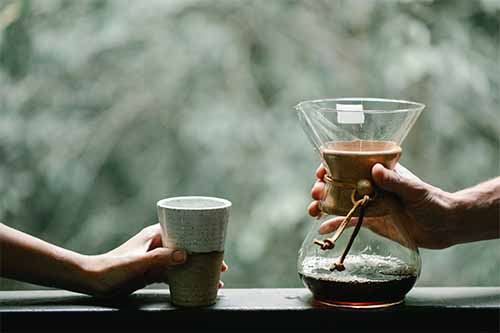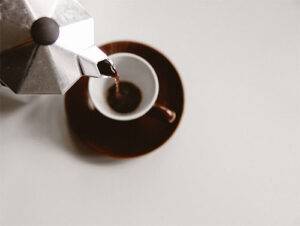The Chemex; people have been enjoying it for nearly 100 years, and it remains one of the best ways to enjoy a light, fruity roast.
What is a Chemex?
A Chemex is a pour-over style glass coffee maker, invented by Peter Schlumbohm in 1941. It consists of an hourglass-shaped glass flask with a wooden collar and tie, used to hold a paper filter, in which coffee is brewed. The Chemex uses a thicker paper filter than a typical drip brew basket, which removes more of the coffee oils, resulting in a cleaner taste. It is a manual, pour-over method of making coffee and is known for producing a clean and flavourful cup.
What Makes the Chemex so Desirable?
Chemex coffee is known for producing coffee that is clean, bright, and flavourful. This is due to several factors:
- The unique design of the Chemex: The hourglass shape of the Chemex allows for a steady and consistent pour, which helps to extract the coffee flavours evenly. The thicker style paper also removes more of the coffee oils than other types of brewers, which gives the coffee it’s much cleaner taste.
- The coffee-to-water ratio: The Chemex uses a relatively high coffee-to-water ratio, which means that more coffee is used per unit of water. This results in a cup that packs far more flavour than your generic brewer.
- The grind size: The Chemex requires a coarse grind size, and when combined with the paper filter it allows for a slower extraction of the coffee flavors which results in a more nuanced and complex cup of coffee.
- The brewing time: The Chemex brewing time is relatively short, which allows for a brighter and more floral taste in the coffee.
- The quality of the water: Chemex coffee is best made with filtered water in order to reduce the presence of chlorine and other impurities that can affect the taste of the finished product.
All these factors combine make Chemex coffee an excellent choice for coffee enthusiasts and connoisseurs. It’s a manual, pour-over method of brewing that requires some attention and skill, but it’s a great way to enjoy a cup of coffee that really brings out the individual flavours of the bean.
How to make Chemex Coffee without a scale:
It is possible to make Chemex coffee without a scale by using measuring cups or spoons. Here are the basic steps:
- Fold the Chemex filter and place in the brew basket, making sure it sits securely and covers the entire bottom of the basket.
- Wet the filter with hot water to remove any papery taste, and then discard the water.
- Measure out the desired amount of coarsely ground coffee using measuring cups or spoons. A good starting point is 1 cup of coffee grounds for every 4 cups of water.
- Slowly pour hot water over the coffee grounds, moving the pour in a circular motion to make sure you wet all of the grounds evenly.
- Remove the filter and discard the coffee grounds.
- Serve the coffee and enjoy!
Keep in mind that the coffee-to-water ratio can vary depending on personal taste, and the brewing time can also be adjusted for a stronger or weaker cup of coffee. It’s recommended to use a scale for more accurate results if you want to perfect your recipe.
How to Make Chemex Coffee With a Scale:
Here are the basic steps to make Chemex coffee using a scale:
- Fold the Chemex filter and place in the brew basket, making sure it sits securely and covers the entire bottom of the basket.
- Wet the filter with hot water to remove any papery taste, and then discard the water.
- Measure out the desired amount of coarsely ground coffee using your scale. A good starting point is a 1:15 coffee-to-water ratio, which means for every 1 gram of coffee, you would use 15 grams of water.
- Slowly pour hot water over the coffee grounds, moving the pour in a circular motion to make sure you wet all of the grounds evenly.
- Remove the filter and discard the coffee grounds.
- Serve the coffee and enjoy!
Remember that the coffee-to-water ratio can be adjusted to suit your personal preferences. Experiment with different ratios to find what works for you, and the specific coffee you are using. You should also pay attention to the water temperature, which should be between 90-96 Celsius.



